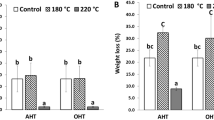Abstract
Wood is a natural and renewable material used extensively. However, it is generally susceptible to biological attacks caused by fungi and termites. Studies showed that copper azole (CA) could effectively inhibit the growth of such organisms. CA belongs to water-borne preservatives and CA-treated wood inevitably suffers from poor dimensional stability. In order to improve the water repellency of CA-treated wood, a paraffin wax emulsion was added to the CA preservative system at different ratios. The compound systems were then used to treat Southern pine (Pinus spp.) samples. The basic properties of the compound systems, such as stability (storage stability and centrifugal stability), particle size and pH value, as well as the weight percent gains, contact angles, water repellency (water absorption, shrinkage and swelling) of treated samples were investigated. The results are as follows: (1) the compound systems of CA and paraffin wax emulsion had a favorable miscibility, and their stabilities all reached level one (good stability); (2) compared with untreated wood, CA-treated samples showed poor water repellency, whereas samples treated with the compound systems indicated an obvious reduction in water absorption, and improved dimensional stability as well.







Similar content being viewed by others
References
AWPA U1-08 (2008) Use category system: user specification for treated wood. American Wood Protection Association, America
Chinese Standard GB/T11543-2008 (2008) Surface active agents—the identification of emulsion for moderate to high viscosity and the evaluation method of emulsifying capability. Standards Press of China, Beijing
Cui W, Kamdem DP (2000) Wood products and wood protection in China. Holzforschung 58(5):387–391
De Vetter L, Van den Bulcke J, Van Acker J (2010) Impact of organosilicon treatments on the wood-water relationship of solid wood. Holzforschung 64:463–468
Dhyani S, Kamdem DP (2012) Bioavailability and form of copper in wood treated with copper-based preservative. Wood Sci Technol 46(6):1203–1213
Donath S, Militz H, Mai C (2006) Creating water-repellent effects on wood by treatment with silanes. Holzforschung 60:40–46
Evans PD, Wingate-Hill R, Cunningham RB (2009) Wax and oil emulsion additives: how effective are they at improving the performance of preservative-treated wood? Forest Prod J 59:66–70
Freeman MH, McIntyre CR (2008) Copper-based wood preservative. Forest Prod J 58:7
Garai RM, Sánchez IC, García RT, Rodríguez Valverde MA, Cabrerizo Vílchez MA, Hidalgo-Álvarez R (2005) Study on the effect of raw material composition on water-repellent capacity of paraffin wax emulsions on wood. J Dispers Sci Technol 26(1):9–18
Kurt R, Krause A, Militz H, Mai C (2008) Hydroxymethylated resorcinol (HMR) priming agent for improved bondability of wax-treated wood. Holzforschung 66:333–338
Laks PE (2008) Wood Preservative Fungicides and the American Wood Preservers’ Association Use Category System. In: Schultz TP (ed) Development of commercial wood preservatives. Oxford University Press, New York, pp 228–240
Lesar B, Humar M (2011) Use of wax emulsions for improvement of wood durability and sorption properties. Eur J Wood Prod 69(2):231–238
Lesar B, Kralj P, Humar M (2009) Montan wax improves performance of boron-based wood preservatives. Int Biodeterior Biodegrad 63(3):306–310
Lesar B, Pavlič M, Petrič M, Škapin AS, Humar M (2011) Wax treatment of wood slows photodegradation. Polym Degrad Stab 96(7):1271–1278
Li C, Mei Z, Liu Q, Wang J, Xu J, Sun D (2010) Formation and properties of paraffin wax submicron emulsions prepared by the emulsion inversion point method. Colloids Surf A 356:71–77
Lin LD, Chen YF, Wang SY et al (2009) Leachability, metal corrosion, and termite resistance of wood treated with copper-based preservative. Int Biodeterior Biodegrad 63(4):533–538
Parker TG (1982) Water repellent and preservative for wood products, Google Patents
Passialis CN, Voulgaridis EV (1999) Water repellent efficiency of organic solvent extractives from Aleppo pine leaves and bark applied to wood. Holzforschung 53:151–155
Peylo A, Willeitner H (1995) The problem of reducing the leachability of boron by water repellents. Holzforschung-Int J Biol Chem Phys Technol Wood 49:211–216
Scholz G, Krause A, Militz H (2010a) Exploratory study on the impregnation of Scots pine sapwood (Pinus sylvestris L.) and European beech (Fagus sylvatica L.) with different hot melting waxes. Wood Sci Technol 44(3):379–388
Scholz G, Militz H, Gascón-Garrido P, Ibiza-Palacios MS, Oliver-Villanueva JV, Peters BC, Fitzgerald CJ (2010b) Improved termite resistance of wood by wax impregnation. Int Biodeterior Biodegrad 64(8):688–693
Schultz TP, Nicholas DD, Ingram LL (2007) Laboratory and outdoor water repellency and dimensional stability of southern pine sapwood treated with a waterborne water repellent made from resin acids. Holzforschung 61(3):317–322
Sinnige LA (1999) Wax emulsion composition for imparting water repellency to gypsum. US Patent 5,968,237
Wang JJ, Xie GJ, Li XW (2011) Study on water repellent performance improvement of ACQ wood preservative. Guangdong For Sci Technol 27(3):59–61
Wang W, Zhu Y, Cao J, Liu R (2014) Improvement of dimensional stability of wood by in situ synthesis of organo-montmorillonite: preparation and properties of modified Southern pine wood. Holzforschung 68(1):29–36
Xie GJ, Li XZ, Wang JJ, Mo ZG (2014) Research on strengthening dimension stability of preservative wood. Guangdong For Sci Technol 6:30–33
Yildiz S (2007) Retention and penetration evaluation of some softwood species treated with copper azole. Build Environ 42(6):2305–2310
Yokoyama N, Araki Y (1984) Wax emulsion. US Patent 4,468,254
Acknowledgements
This study is financially supported by Fundamental Research Funds for the Central Universities of China (No. 2015ZCQ-CL-01).
Author information
Authors and Affiliations
Corresponding author
Rights and permissions
About this article
Cite this article
Wang, J., Zhong, H., Ma, E. et al. Properties of wood treated with compound systems of paraffin wax emulsion and copper azole. Eur. J. Wood Prod. 76, 315–323 (2018). https://doi.org/10.1007/s00107-016-1111-5
Received:
Published:
Issue Date:
DOI: https://doi.org/10.1007/s00107-016-1111-5




